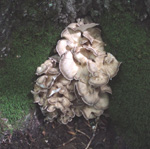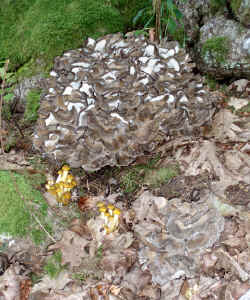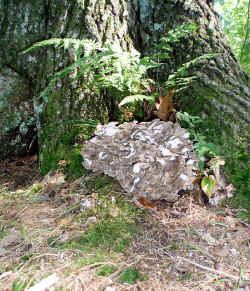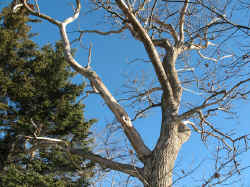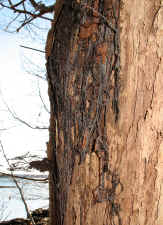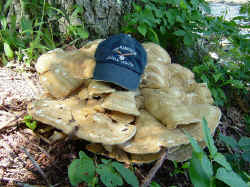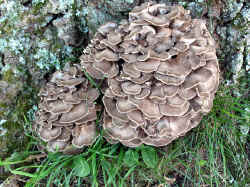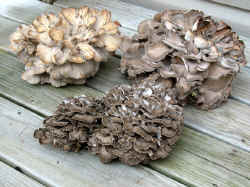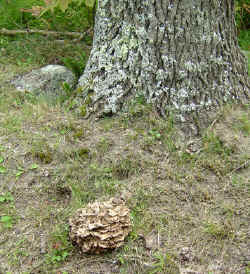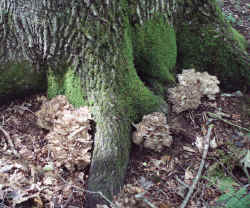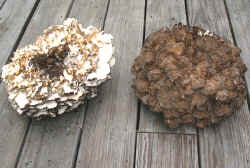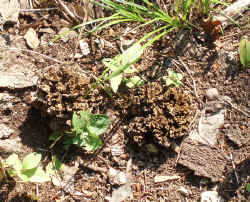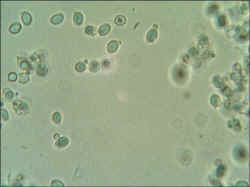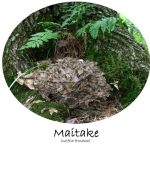|
|
A New England and Eastern Canada Edible and Medicinal Mushroom Resource |
||
|
Maitake (my-tah-keh) is the Japanese name for the edible fungus Grifola frondosa. I look forward to labor day when the maitake begin to appear in Maine. It is called the dancing mushroom probably because of the excitement generated by finding it. It works for me. It has a distinctive smell and flavor. In addition to being a great edible there is growing evidence that it is highly medicinal, boosting the immune system to fight cancer and stabilizing blood sugar and blood pressure. Maitake may have antihypertensive and antidiabetic properties as well. Fruit body (whole mushroom) Maitake is composed of clusters of flattened caps that can be reminiscent of a feather duster or a sitting hen. The fruit body can be 4-36 in. across or more. From the bottom, the stem and branch structure may remind you of the underside of a cauliflower. The weight of the cluster usually is in the 3 - 15 lb. range but they can grow much larger. A local mushroom broker in Maine purchased an 85 lb. specimen a few years back that required delivery on a child's plastic snow sled. Cap (pileus) Each individual cap can be 3/4 - 3+ in. across with grayish to brownish tones often with a whitish zone in the middle of the cap. Caps are about 1/8-1/4 inch thick. Sometimes thinner. Pores (hymenophore) The pore surface is grayish in younger specimens becoming more white with age and developing some yellow or brown tones as it passes it's peak. Stem (stipe) A single central white stem with a complex branched structure like cauliflower or broccoli. Flesh White flesh that toughens a bit with age. Spores White spore print. The spores are fairly easy to propagate. When and where to find them (ecology) They are found from Sept. 1 to as late as early November in some years on mature oaks that often have dying branches. Look in parks, on lawns, edges, and low somewhat wet areas. Red oak is particularly good. Dead stumps should not be overlooked. 2005 was an off year for maitake and the only ones I found that year were by dead stumps. Ponds, lakes and coastal areas with a lot of very mature oak are likely places. Often a tree will have several to many individual fruit bodies. I found thirteen around one tree this past year. They may grow all at once or sometimes come out over a period of two or three weeks. It is a good idea to keep checking a tree where you found some. Most years I find one or two under a certain black locust. Greg Marley, a local mycologist, found one under a Red maple this past season. In the locations where you discover them they are likely to reappear for many years. Young and middle aged healthy trees seldom harbor maitake. I find them in close proximity to honey mushrooms quite often as the photographs indicate. Preparation For the table, maitake may be the most versatile mushroom of all. It has a unique, truly excellent flavor that neither overpowers nor is easily overpowered. I think it has a slightly astringent edge. It is great sautéed, deep-fried, microwaved, boiled, and dried. I love this one! It has a really pleasant, crunchy, very chewable texture all the way down the stem. A moderately thick batter is best for deep frying maitake. I have it on good report that you can freeze them raw and break off pieces for cooking all winter. Sautéed maitake freezes well and certainly makes excellent duxelles. I have eaten dried maitake like chips dipping them in Boursin cheese. If you find three or four you can easily have 20-50 lbs. of mushrooms. That's just too much for immediate consumption. Maitake makes a really good duxelles. Drying is often necessary. Larger, older dried maitake might be a little chewy when rehydrated and would be best made into powder. The dried mushroom powder can be used to add flavor to meatloaf, pasta sauce, gravy, béchamel based sauces, etc. You can use a lot because the powder has a subtle flavor. See my ratings. Go nuts with this one! It also makes a pleasant medicinal tea. I have made a surprisingly pleasant maitake-reishi liquor. Comments Apparently this mushroom has caused minor illness for at least a few people although I have never met anyone who had a problem with it. The supermarkets sell it. As always try a small amount at first. If you have health issues or take medication there is a possibility of interaction. Check with your doctor. Many doctors are not well informed about mushrooms though. It does vaguely resemble the much larger berkeley's polypore (Bondarzewia berkeleyi) and the black staining Meripilus giganteus, both of which apparently are non poisonous. I have tried Berkeley's polypore and it is slightly bitter but OK. The dried product seems to be better but needs more testing. They are probably best left alone. Berkeley's Polypore (Bondarzewia berkeleyi) also grows under oak and looks vaguely similar but is much larger and thicker. It fruits earlier in the season. It is edible but not nearly as good developing bitterness with age. Maitake can be used for dyeing textiles or paper and will yield a soft yellow color when ammonia is used as a mordant. Since preparing them for cooking or drying usually leaves a lot of trim, this may be a good use for it. There is information being developed about the medicinal properties of this mushroom that is very promising. They contain complex polysaccharides known as beta glucans that enhance the function of the immune system. The American Cancer Society has positive things to say about maitake and there are breast cancer studies being conducted at at Sloan-Kettering Cancer Center. I have a personal story. In early 2004 I learned that my son had a classmate in the 6th grade who was diagnosed with stage 2 malignant infiltrating astrocytoma (brain cancer). It was in her thalamus and around her hypothalamus/pituitary glands and was inoperable. Amalie was given less than a year to live. Radiation and chemo were not an option because of it's location. Further, it would have prevented her from reaching puberty. She was on anti-convulsive medication only. After hearing about this, I gave her mother about half a bushel of maitake I had collected and dried. It was consumed as regular food at their house. Much to her doctor's surprise, the cancer stopped growing. Amalie's tumor has not disappeared but has not grown or progressed as doctors had expected it to. It has been 5 years with no new growth and the only medication she now takes is the anti-convulsive. Amalie did reach puberty and is healthy and attending school regularly. She has a boyfriend and is a normal eleventh grader. She only needs six month checkups at this point. The doctor stated that this is not what she had expected and is hopeful. I have continued to give them a big bag of dried maitake each fall.(The previous two paragraphs were edited for accuracy by Amalie's mother) Find more information here: Maitake/Hen of the Woods at AmericanMushrooms.com If you like my photography, I have products like tee
shirts, aprons, coffee cups, and other items
available here.
Copyright 2011 Mushroom-Collecting.com. All rights reserved. Use of this site will constitute your acceptance of the disclaimer. |
